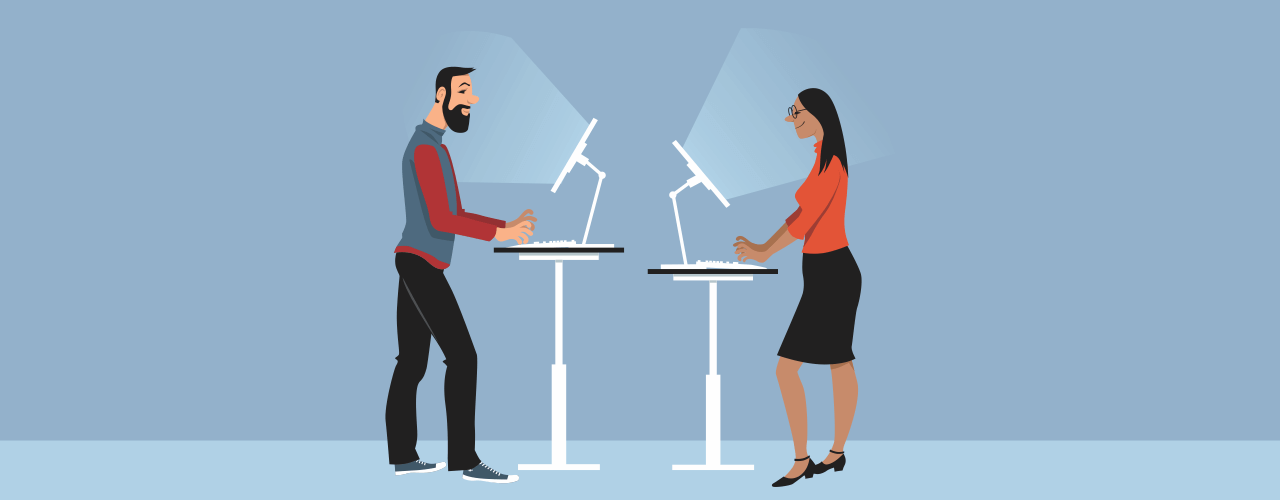In today’s technology-governed world, where most jobs require sitting in front of computer screens all day long, we often don’t even realize how sedentary our lives have become. Compared to the 1960’s, when at least half the jobs in America came with at least some form of physical activity, nowadays less than 20% of the population enjoy this potential health advantage. These days over 80% of Americans work jobs that require sitting for over 8 hours per day and this inactivity can cause major health concerns over time.
But why is staying seated throughout the day so dangerous and what can actually be done about it? Are standing desks, introduced as a countermeasure, effective and do they grant us any kind of health benefits? How can we work in an office and stay healthy in the long run? After some thorough research, here’s what we’ve found:
What is wrong with sitting down?
Just like with everything done in excess, sitting for extended periods of time for days on end can seriously damage your overall health. It can not only contribute to gaining weight, but can also cause poor blood circulation, weaken the muscles and can lead to chronic body pain, especially in the neck, shoulders, back and the legs.
A number of heart diseases have also been linked to staying still in front of a desk all day long, along with a higher risk of diabetes, brain damage and mental health problems like depression and anxiety. Furthermore, a handful of studies claim that sitting for over 8 hours daily without practicing any sort of physical activity has consequences that are somewhat similar to those posed by obesity and even smoking.
To combat this, a new trend in functional furniture design emerged, which presented standing desks as the ultimate solution to solving all these problems.
What are standing desks?
Standing desks are exactly what their name suggests: tall desk spaces adjusted to your height next to which you can work in a standing position or by sitting on a high stool. A few variations of standing desks have been developed over the years. Sit-stand desks give you the opportunity to choose between a sedentary position and standing up, which you can easily modify with a hand crank or an electric motor. Some have drawers to offer space for storing your items, whilst others come with foot rails to help reduce back pain.
Although standing desks have taken the office world by storm, with most hip companies incorporating at least a handful of them into their work stations, are they actually better and more beneficial than sitting down? Apparently they may not be as great as we think they are.
What the research says
Despite the claims that standing desks can help you burn more calories, a Harvard study found that standing only burns about 8 calories more an hour than if you were seated. They also state that after you’ve been doing your job in a sedentary position for a long amount of time, abruptly changing to standing desks puts you at risk of developing back, leg and foot pain. If you’re set on making this change, make sure you start with shorter, 30 to 60 minute sequences, gradually increasing your standing time as you go.
Another study that analyzed 40,000 participants found that standing for prolonged periods of time doubled, and in some cases tripled, people’s need for surgery to treat varicose veins. Researchers analyzing 7,000 individuals over a period of 12 years published findings which indicate that people who worked in a standing position had double the risk of heart disease compared to people who mostly work sitting down.
What to do instead to stay healthy
As it turns out, it’s not sitting all day long that produces our biggest problems, it’s actually not moving and staying in one place that causes all those health issues. In order to lessen these worrying risks that everyone working a sedentary job is prone to, one must continuously pay attention and make an effort to incorporate short bursts of activity throughout the work day.
Simple but regular practices such as standing up and simply pacing beside your desk every 30-45 minutes for at least 5-10 minutes at a time can go a long way to helping. And a few sets of push-ups, crunches and squats are always beneficial. Similarly, taking a walk around the block during your lunch break, breathing in the fresh air and getting outdoors also help a lot. If your motivation needs a bit of boost, couple up with your favorite co-worker to keep each other accountable.
Naturally, incorporating a regular exercise routine outside your work hours can also benefit your overall health in many ways. But instead of signing up for a gym membership and attending boot camp-style workouts which you’ll soon grow to hate, try out a handful of different exercise routines instead, to find out what you like most. Attend a yoga class, show up to an organized work-out session or simply go for a run in the wee hours of the morning before you head to work. The most important thing is to love what you are doing, so that you can make a habit out of it and practice it on a regular basis, which will surely keep you healthy and motivated, despite the sedentary nature of your working life.









